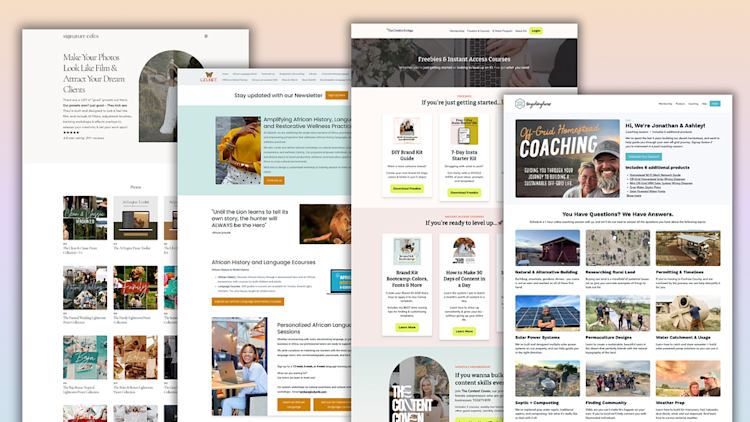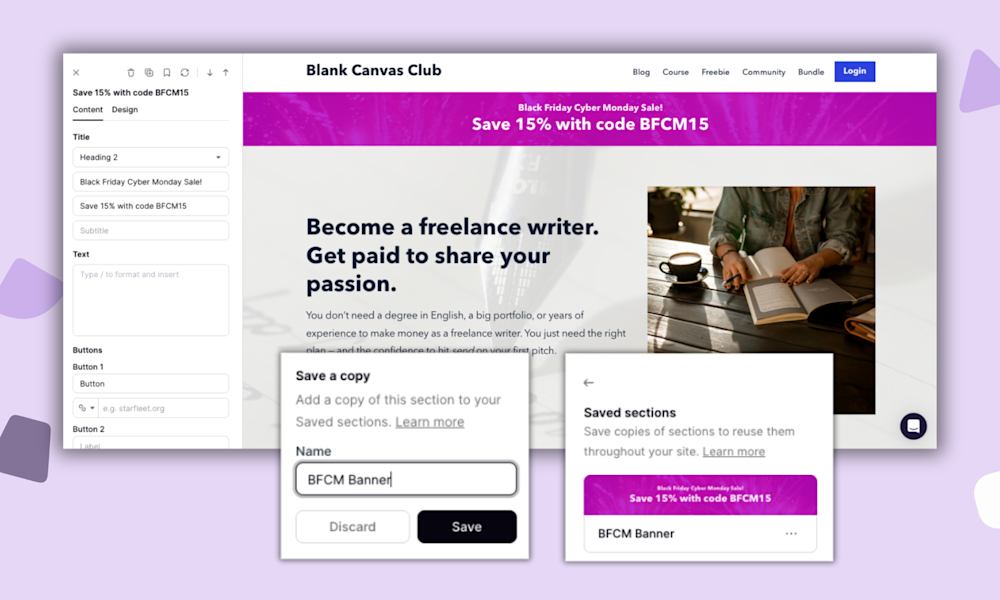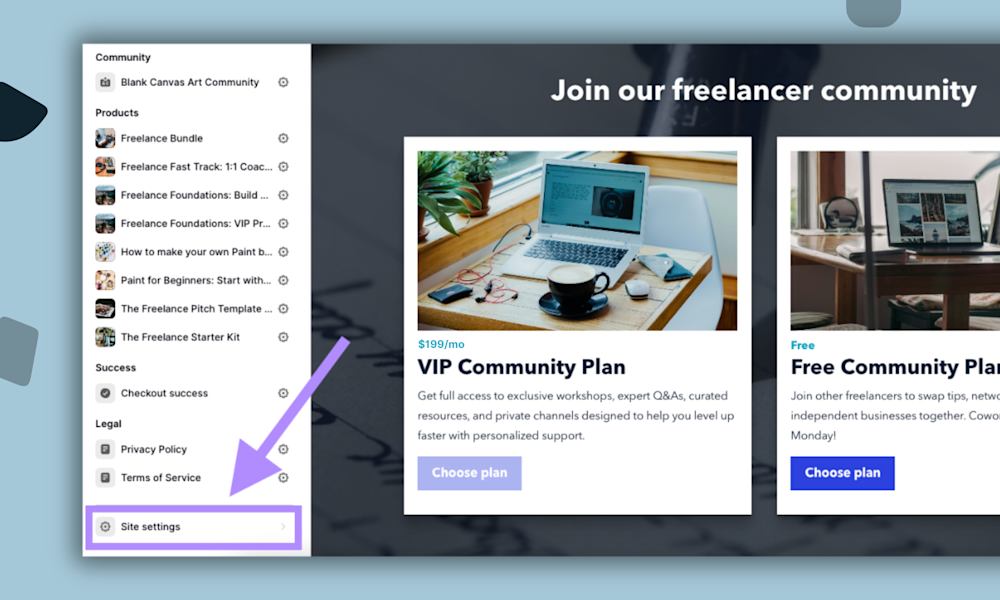If you’re trying to monetize your social media following, you might be thinking about landing brand deals, securing sponsorships, or squeezing out another drop of ad revenue.
But waiting for your dream brand deal to land in your inbox isn’t a business strategy. It’s a gamble.
The smarter way to monetize your social media audience is to own the relationship with your followers directly. Selling digital products, memberships, and courses lets you turn their attention into income on your terms, and getting followers onto your email list ensures that you can nurture the relationship long into the future.
In this article, we’ll cover:
-
Why social media partnerships alone aren’t a reliable income source
-
How to diversify your revenue streams beyond brand deals
-
Steps to turn your followers into paying customers using digital products
By the end, you’ll know exactly how to monetize your social media following in a way that gives you more control, stability, and ownership of your income.
Relying on social media partnerships and ads limits your income potential
You probably got your audience on social media because you make really good content. But you don’t get paid nearly enough in sponsored content to compensate for your time, and algorithm shifts can mean huge differences in your payouts month to month.
Brand deals can be feast or famine, and you’re constantly pitching, negotiating, and waiting for approval from companies. Not to mention that you’re always a little nervous that your platform of choice will change its policies (or disappear entirely) with no notice.
Social media platforms are businesses, and they’ll do what’s best for their bottom line, even if that means slashing your reach and profits overnight.
Instead, do what thousands of Podia solopreneurs just like you have done and use the audience you’ve grown to fuel a business that you own.
A business where you have the final say over your income, sales, products, and customer relationships. Here’s how.
How to use your social media audience to build a business that you actually own.
Unlike brand deals and ad revenue, digital products keep working for you long after you create them. Instead of chasing the next viral post, you can make something once and earn money from it over and over again.
First, you’ll decide what type of product to make and what topic to cover. Then you’ll build a system for consistently getting followers onto your email list and into your products on autopilot.
That way, when a dream brand deal finally lands in your inbox, it’s just the icing on the cake of your already successful business.
“Don’t put all your eggs in one basket. That’s why we don’t just make videos but also products that go along with them, the community, and other sources of revenue that we own.” — YouTuber Jonathan Longnecker
Step 1: Choose the right type of product for you and your audience
The best digital products solve a problem, and we’ll sort out your topic in Step 2, but it should also be in a format that you enjoy making.
If you hate writing, an ebook won’t be your move. If you love connecting with people 1:1, a membership or coaching program might be a better fit.

Luckily, you’ve got options. Here are some ideas for what you can make:
Offer digital downloads: With a digital download, you can create templates, checklists, ebooks, guides, or presets that solve a problem for your audience. This is great for giving your people a quick win, and you can put together your first download in less time than you think.
Sell an online course: Courses work great if you want to teach with lots of media options, like video, images, text, and audio. This format is also ideal for more complicated topics that need to be organized in modules or lessons.
You can set up courses that are self-paced, live cohorts, or limited access, and you can enable discussions within your courses to let students work together.
Launch a membership community: If you want to talk to your audience more closely on a platform away from social media, a community could be right for you. We see solo business owners use paid membership communities to share exclusive content, host live sessions, answer questions, and give feedback, all while earning recurring income.
Host paid webinars or live workshops: A workshop or webinar is a good in-between where you give live support and feedback, but only for a short time. Webinars are usually around an hour and cover one specific topic in depth. You can also sell the webinar replay as recurring revenue after the live session wraps. (Here’s how to sell a pre-recorded webinar or replay in Podia.)
Run coaching programs: If you want to work with clients individually, you can offer private coaching or group coaching sessions. Coaching ties in well with fitness, business development, mindset, or anything else where a personalized approach is best.
Done-for-you services: If you offer a service, like graphic design or website development, it might make more sense to sell done-for-you services. This lets your audience pay you to handle the work and deliver a finished product based on what they need.
Now that you know what kind of product to make, let’s narrow down your topic idea.
Step 2: Picking your million-dollar topic
You’ve already done the hard work of building your following, so you probably have a good sense of what your people are interested in.
But to get ultra-specific and make sure you’re speaking to real pain points, goals, and desires, I recommend talking to them directly.
Start by asking these questions through polls, surveys, comments, DMs, or even 1:1 calls:
-
What’s preventing you from achieving [desired outcome]?
-
What problems do you keep running into?
-
What’s the #1 thing you’d pay to learn right now?
-
If I could make one resource to help you with [goal], what would it be?
For instance, when founder and community builder Casey Richardson was making her first course, she posted on social media asking to talk to followers for 15 minutes.

Instead of discussing course content or marketing herself, Casey asked questions like, “What keeps you up at night? What is your biggest fear? In one year, where do you want to be?” She used the time to make the people in her target audience feel seen and understood, and by the end, most of them were asking, “Can I buy the course now?”
Casey kept these people’s email addresses so she could let them know when the course was live, and when she launched, 80% of the people she spoke to on those initial calls converted to customers.
As you figure out the topic for your paid product, talk to your audience. You’ve worked hard to find them, now let them help you make a product they can’t wait to buy.
Step 3: Build a system that brings social media subscribers onto your email list
Once you have your digital product, it’s tempting to just slap it up on social media and call it a day. And you’ll probably get some sales at first, but over time people will forget, and you’ll be stuck in that same cycle of promoting stuff 24/7.
Instead, we’ll build a system that brings your social media subscribers onto your email list, where you can send automated marketing emails that promote your products naturally over time.
Here’s how to get your followers to make the oh-so-important jump from casual social media fans to engaged subscribers (and long-term customers).
-
Create a lead magnet
-
Set up an email automation
-
Send regular newsletters
Create a lead magnet that’s related to your paid product or main topic
A free lead magnet is a resource you give away in exchange for joining your email list. Your freebie doesn’t need to be super elaborate — a checklist, template, or list of tips can work wonders — and it should be somewhat related to your paid product.
You can put your freebie right at the top of your link in bio, link to it in your captions, share it in your stories, and post it anywhere else people might go to learn more about you. Since it’s free, you’ll likely get more signups than you would for a paid product.
To set up your lead magnet in Podia, add your file as a new product and set the price to “Free email delivery.” You can add a signup box anywhere on your website, and when someone joins, they’ll get the download delivered straight to their inbox.

Automatically send a series of emails after someone signs up
After someone downloads your lead magnet and joins your list, you can send them an automated email campaign over the next several days. This allows you to “magically appear” in their inbox without having to literally send each message one by one.
To keep things simple, you can start with this easy three-step email automation. Space these out by 1–2 days so you stay top of mind while getting to know your new subscriber.
-
Email 1: Send a welcome email where you share information about you and your business. You can also remind them how they can access their free lead magnet.
-
Email 2: Share tips, helpful advice, popular content, or other free valuable information to make them think, “This person knows their stuff.”
-
Email 3: Tell them about your paid product. You can include testimonials and reviews if you have them, and make sure you give them a clear buy button where they can purchase.
Yep, we waited until email three to mention your product, but this was strategic.
This gives you time to build trust and show your expertise before putting on your sales hat. As you nurture your new connections, you make it easier for them to say “heck yes” when you do start talking about your paid products.

Podia Email has automated campaigns built in, and you can set up an email series with as many messages as you want. The nice thing is that your products are automatically connected to your email in Podia, so you can set your automated campaign to run whenever someone signs up for your lead magnet without any complicated integrations.
Regularly send out an email newsletter
You’ve given away a lead magnet and your subscribers have been welcomed to your business with an automatic email campaign. Now you can continue to build that relationship through your newsletter.
Sending out a regular email newsletter is a great way to stay top of mind and connect with followers. You can promote new social media content, share blog posts, offer advice, give behind-the-scenes stories, and let them know about all your upcoming products and projects.

These things can get lost on social media, but when you’re landing in someone’s inbox, you’re more likely to grab their attention.
Cindy Cisneros from The Creativity Courses says, “I’ve noticed that my email open and click rates are high, and I can easily nurture and grow my audience using filters and campaigns that link back to my courses, services, announcements, promotions, and more. It’s a clear, effective, and user-friendly way to stay connected — something that felt lost when I relied solely on social media.”

Having a newsletter means you’ve got a reliable place to launch new products and get feedback from your most enthusiastic fans, so you can make sure you’re always putting out work that your audience loves.
Step 4: Optimize and grow your business with social media and digital products
You’ve got the audience, a great product, and a system for getting people onto your email list so you can connect with them in a space that you own. The final step to monetize your social media following is to adjust, optimize, and expand on this system as you grow.
Here are some ways you can do that:
-
Regularly ask for feedback: See what your audience loves (or doesn’t love) by asking them directly. Send surveys, post polls, or reach out to people for 1:1 chats. Your customers might tell you exactly what they want you to make, which makes your job pretty easy.
-
Test ideas with presales: If you’re not sure how well a specific product will perform, experiment with preselling it. With a presale, you can let people buy your product before it’s ready to gauge interest. You can also ask for input from early buyers to make the product even better. (More on presales in this help doc)
-
Launch bigger with waitlists: Similar to preselling, a waitlist is a great way to see how many people are interested in a product, and it can help you have bigger launch days. While you’re building, set a product to waitlist mode. This lets people sign up to be notified when your product is available, and you can even give away bonuses and discounts to people on the waitlist if you want. (More on waitlists in this help doc)
-
Scale your successful products: When you have a product that’s bringing in big numbers, consider creating more products, resources, or coaching programs around that topic. You can turn this into a product bundle or add an upsell to increase your sales.

A final thing to note: No one sets everything up perfectly from day one. Start by creating one product based on your audience’s feedback. Then add one lead magnet, a short welcome sequence, and a consistent newsletter. Ask for feedback and adjust as you go.
The best products shift and adapt as your business evolves, so consider this the first step on your journey to more profits and more control over everything you’ve built.
Turn your audience into a thriving business
Instead of chasing brand deals or relying on platform payouts, build a business you own by selling digital products, memberships, and courses.
Podia makes it easy to monetize your following and grow beyond social media dependence. Best of all, you can experiment with multiple income streams all in one place, so you’re free to try whatever strikes your fancy.
-
Choose your product type (like a course, download, community, or coaching offer) based on what you enjoy making.
-
Talk to your social media audience to find out what topics they’re interested in and what problems you can help them solve.
-
Set up a system that sends people to your product on autopilot. Share a free lead magnet on social media, then send people an automated welcome series after they subscribe that includes product promotion.
-
Build connections off of social media through your email list and newsletter.
-
Test and refine your products as you go, using your audience as your guide.
Brand deals come and go. Algorithms change. But a business you own? That’s yours forever. Start building your creator business today with Podia. Try it free for 30 days.



